
Page Three

To return to the main page, CLICK HERE. To go to Page 2, CLICK HERE.
The ONLY independent, unbiased source of information on the world's greatest architect, Frank Lloyd Wright, and his work.
|
a supplement to the printed FLlW UPDATE, this update 21 March 2018 All items in this website © copyright 2018 W A Storrer |
This site is maintained by William Allin Storrer, Ph.D., adjunct professor of architecture at the University of Texas at Austin and author of The Frank Lloyd Wright Companion now in a revised edition, and The Architecture of Frank Lloyd Wright, a complete catalog, now in its fourth edition.
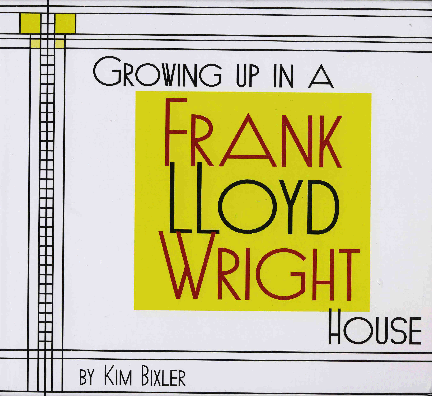 |
| Here is the latest of books written by someone who has lived in a Frank Lloyd Wright house and has had her life infused and altered by the experience. What is wonderful is that this is someone of three generations after the house was designed, raised in more modern times, yet lived in an "old" house and loved the experience. It reveals nicely how Wright could affect generations beyond his own era, positively. |
Completion of the 3-volume (Complete) Frank Lloyd Wright from Taschen.
This is a stupendous effort of the part of Bruce Brooks Pfeiffer. He has rethought what he presented in the 12-volume Monograph and given us new dates and, more importantly, a visual presentation that is stunning. Photos and graphics 15.75 inches wide by 12 inches high adorn many pages. Some drawing spread across the full 31.5 inches on facing pages. Only those fortunate to have obtained either of the two Selected Drawings Portfolios from Horizon Press, 1977 and 1979 will have seen anything equal. Much of Wright's work is documented as never before; Taliesin West commands 32 pages! Yet there are caveats, and I must emphasize the failure of co-editor Peter Gossel to obtain the finest supportive photos. While there are many stunning photographs, there are also some wretched ones where good ones exist and could have been had from myself and many others of my acquaintance. I know, because I offered Mr Gössel anything from my files after Julius Shulman introduced and recommended me to Benedict Taschen.
But, First things first. It is not complete. Even so, you'll probably want it for what it does offer.
Where this volume may be called 'complete' is that it includes all the projects as well as the built work, everything, apparently, in the archives of the Frank Lloyd Wright Foundation. For each item there are the drawings, reproduced in color. For each built work there are also photos, sometimes black & white, often in color.. All they asked for was my copy of Aaron Green's photo of the Berger (Eddie's) Dog House, S.330A.
S.176, the William B Greene house is shown from the north, the Harry Robinson alterations and addition side, while a photo of the original all-Wright was available. The Loren Pope house, S.268, is shown at its National Trust site, with the shadows falling in a way they never would have at the original site. Barnsdall Residence B, S.211, features what is apparently Wright's first use of the all-glass (butted) corner window. A photo of that should have been used (it is available from this website's author).
Time and again, the best available photo is not used. Gossel failed Pfeiffer big time. For instance, my entire archive of over 30,000 photos was made available to Goesel. He could find better color photos in The Architecture of Frank Lloyd Wright, A Complete Catalog, and better photos in B&W in The Frank Lloyd Wright Companion, most of which are also available in color! Why did he not use them? I offered them!
With these, and other caveats below, this is still both the least expensive and most fully-documented collection of the works of Frank Lloyd Wright.Welcome it is!
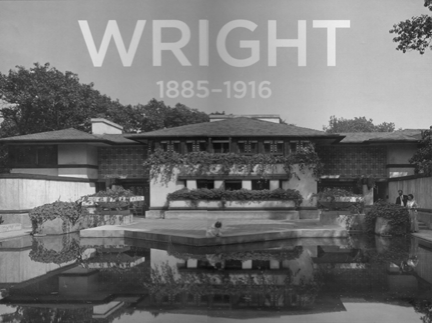 |
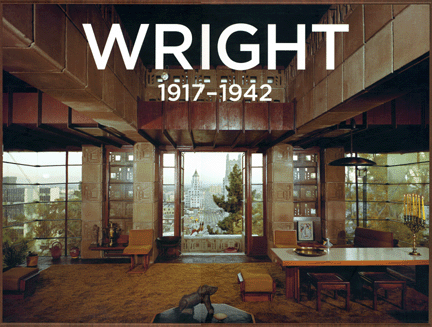 |
 |
| An American Proceeding, subtitled Building the Grant house with Frank Lloyd Wright, by the eldest Grant child, Donna Grant Reilly, is a wonderful book (Meadowside Press, Hanover, N.H., 2010, 196 pps $22.95). It might bring a tear to your eye.
Mrs Reilly experienced the entire process, from living in the first house built by her parents to their deciding to build a second house, designed by Frank Lloyd Wright (S.288), then the building thereof and living within. She documents visits to Taliesin, the quarrying of the limestone on the property, the use of aspen trees from the property to support the roof frames for the huge cantilevered concrete roof, and many other details of construction, all by her parents while she grew into her teens, a time when she could enjoy the wonder of it all. There have been other books about individual houses - still not as many as I'd hoped for when I did The Architecture of Frank Lloyd Wright, a complete catalog - yet the list keeps growing, but few are as delightfully-written as this. As the child Donna, she witnessed events without preconceptions. As an adult, she demonstrates a talent for writing, as good as many a novelist, and her telling of the tale is filled with details of memories that will engage the reader at every turn. Sorry am I, then, that, such a book can hardly be published at any reasonable price if it includes color. So there is none; I offer here two, the living room, and a view down the long stairway to the living room from the entry. Also, the plan in the book is but one floor and is gray on gray. I here offer both floors, in black on white, so you can follow the author's description as she walks you through the structure. |
 |
|
 |
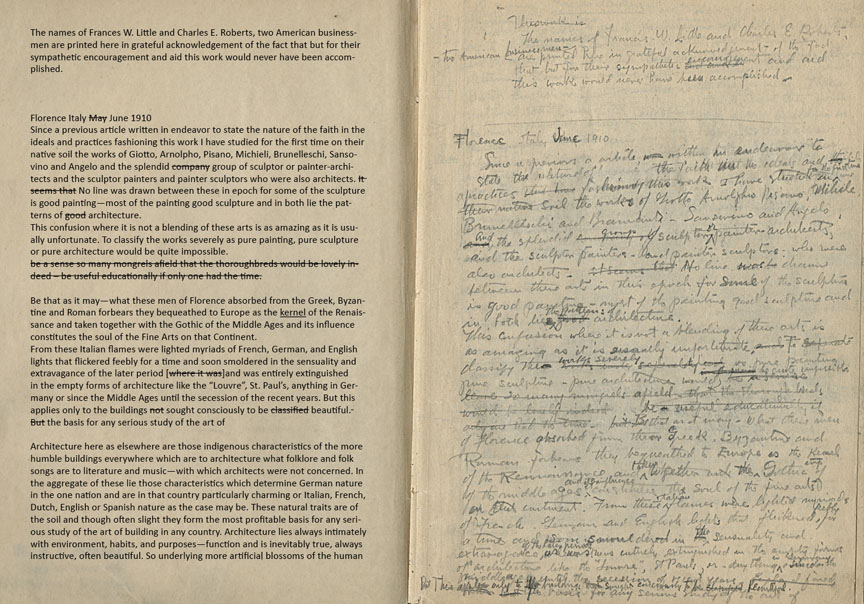 |
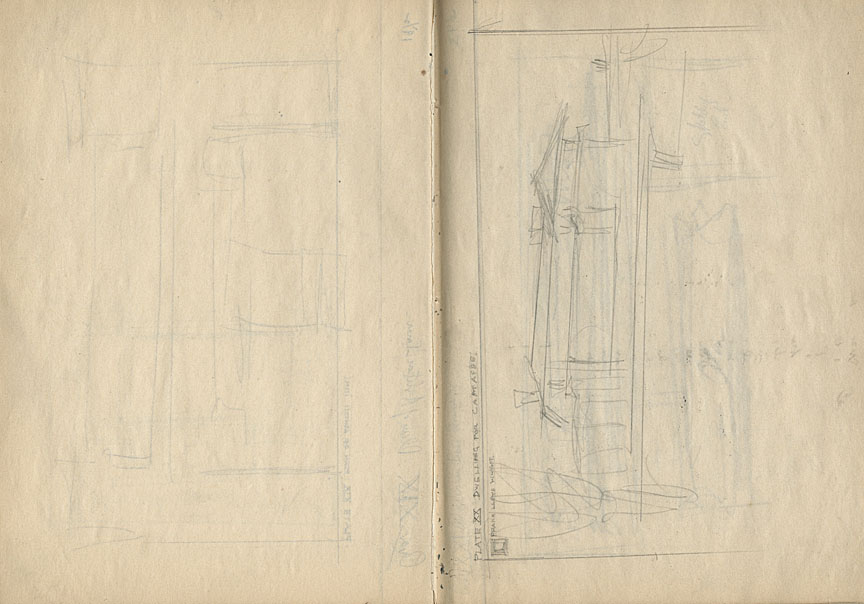 |
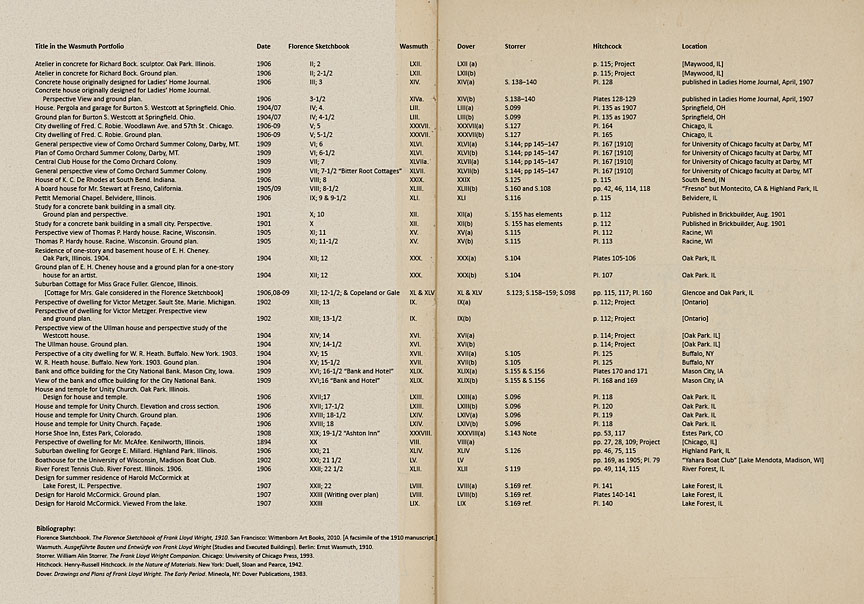 |
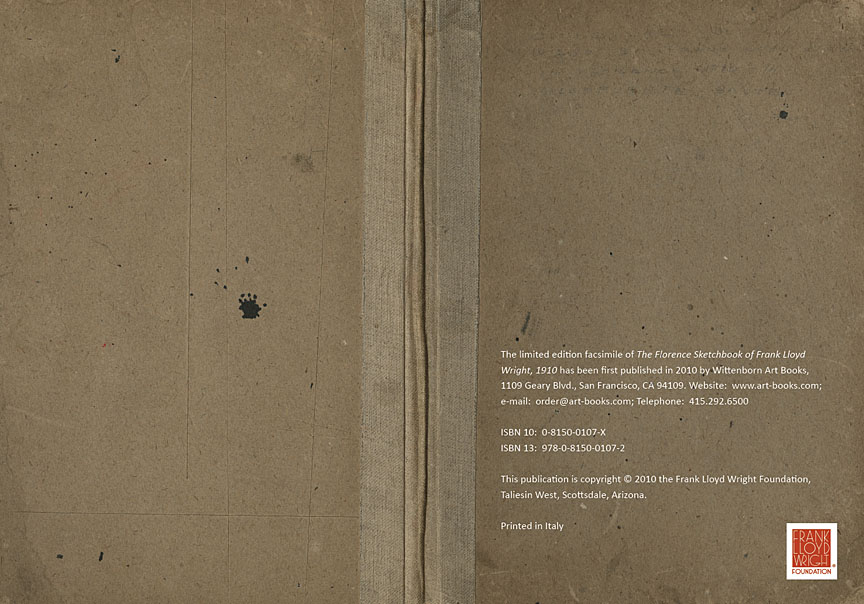 |
Florida Travel + Life Magazine has a fine article in the June 2008 issue. CLICK HERE.
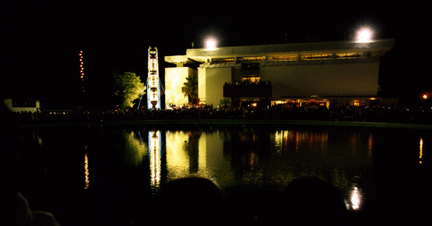 |
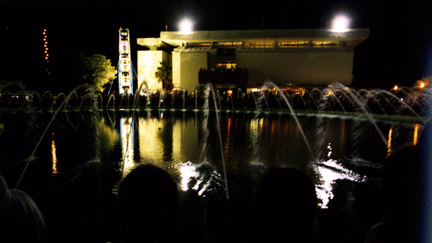 |
||
| Florida Southern College, view towards Nils Schweizer's Roux Library across the Water Dome pond; ferris wheel to the left, and light tower further left, with the Administration building at center left. | 7:37 pm, the switch is thrown. | ||
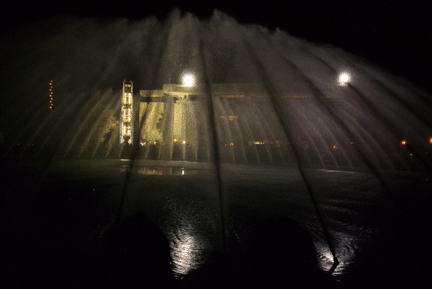 |
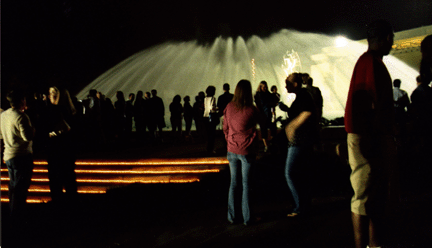 |
||
| Power held to about 60% to keep viewers from getting soaked in the light wind. | Upwind. |
The Florida Southern College Water Dome, S.255A.
69 years from design to finished working unit. This is the first Frank Lloyd Wright work
to be completed on the original site for the original client without alteration since 1966.

As you well can see, daytime with rainbow is much more interesting than plain lights at night.
| Others travelling in SE New York State or SW Connecticut and curious about all the brouhaha surrounding the Massaro attempt with Tom Heinz to build the Chahroudi residence (See S.346) might wish to consider the following: | ||
|
||
MASSARO VERSUS WRIGHT
|
|
The images above are of CSAIL, the acronym given Frank Gehry's building for MIT by the students. Others call it SART. Finding that students didn't think MIT sufficiently avant-garde, MIT commissioned Gehry to do them a building in their overcrowded part of Cambridge. What the got looks a lot like a full box of children's colorful toys, without the box. Students hate it, largely because the building was designed with no concern for how spaces would be used. Rooms were projections are required routinely cannot be darkened, the odd-shaped windows denying any standard way of covering. The photo below is seen through a glass wall, a floor above the only open access to the ledge, by ladder. Why place a ledge there anyway? And so on. Yet this sculptor is still hired by people who think he is an architect . Many who have seen the Walt Disney Concert Hall in Los Angeles have been overwhelmed by its architecture, and thus may not be listening critically to its sound. We now have an independant view of its acoustics and other problems which could make it a white elephant within the decade. The information comes from someone who travels with orchestras, knows how they sound in great halls such as Boston Symphony Hall, Detroit Orchestra Hall, Hill Auditorium in Ann Arbor, Louis Sullivan's famed auditorium in Chicago, and Frank Lloyd Wright's Gammage Auditorium in Tempe, Arizona. Here are his comments, edited only for brevity. The building is a design Gehry had worked on for another project pre 9/11. Thus, it is a security nightmare, with entrances on all sides of the building. Whenever a visiting orchestra or other group, such as the Israel Philharmonic, is playing, the entire city block has to be cordoned off by a massive police contingent. In the long run, the cost of this will be prohibitive. Next, the underground parking garage has to be closed two days before such an event. A van filled with explosives equal to what were set off in the early nineties in the World Trade Center would level the Disney to the ground. Here is further loss of revenue. Finally, this old design of Gehry, sort of "pulled out of his pocket" when Disney coughed up the funding, has each ticket-price section of the hall physically separated from other sections. Thus an inordinate number of ushers need to be hired during concerts, again raising operational costs. My advisors suggest that a decade will speak the death knell for the building unless some outrageously wealthy donor kicks in multi-millions on an annual basis. The Gehry structure in the park in Seattle has already lost the upkeep funding of its original multi-millionaire, so the prognosis is not good. All this, and the acoustics are bright, not warm. Musicians often cannot hear others a few desks away, so ensemble can be ragged, yet the turning of a page on stage projects into the auditorium. When a truly large orchestra plays fffff, the sound breaks up, overloading the hall. MORE . . . The following article appeared in Volume 4, Number 15 of the Classical NEW JERSEY Society Journal The Myth of the Walt Disney Concert Hall Should you end up in L.A. ... Sunday March 28 By A. Michael Noll The Walt Disney Concert Hall opened last year as the new home of the Los Angeles Philharmonic. Designed by Frank Gehry, the hall has been acclaimed by critics for its fine acoustics and also for its impressive and novel architecture. Although the architecture is indeed impressive and the hall looks quite nice, the acoustics are not good, . . . CLICK HERE to continue |
There is really only one way to "view" Wright if one wishes to gain an understanding of his genius. One must go into the buildings. Standing outside and look at the building, however much that may reveal what is in side (as good organic design will), is a fruitless pursuit. There are now a few buildings by Wright that are available for rental by the week or weekend, and a bed & breakfast, as well as several sites that may be visited for a small fee on a daily basis. The Architecture of Frank Lloyd Wright, a Complete Catalog, 4th Edition, has a complete listing of sites open to visitors with information on tours and such.
"It is possible to understand even as one cannot emulate. This is why
Wright has so few followers and no true successors. Understanding is
not enough."This isthe ONLY independant,
unbiased source of information on the world's greatest architect,
Frank Lloyd Wright, and his work.
Herewith some answers to the challenge I made to all academics who claim to be experts on the architecture of Frank Lloyd Wright or who otherwise teach courses on the work of the master. They were to demonstrate their knowledge or admit they were deficient. From Cambridge to Madison, many failed to prove their worthiness. Here is a site with items under consideration as possibly by Wright. Weigh in with your conclusions, either yes, or no, or possibly, and why. No excuses. If you want more information, email for what is available. What is shown should, however, be sufficient. CLICK HERE.
When we have no reliable photographic evidence together with a plan from the archives of the Frank Lloyd Wright Foundation, how do we know if a work was built in any form, or as designed, nor not at all ? This is important regarding S.132, S.143, S.123, S.124 and S.223, among others. Or the buildings that were collaborations, not unique Wright works, such as S.010, S.033, S.045 and S/014. But here, this is all about "built works that weren't!" In April 2000 I went to Damietta and the east branch of the Nile delta, to check out the cottages at or near there. Here is a genearal statement, and a report on the Egyptian cottages. Click HERE.
FRANK LLOYD WRIGHT'S ARIZONA BILTMORE HOTEL (S.221)
|
|
Balthazar Korab is one of the finest architectural photographers to have found Frank Lloyd Wright's work a suitable subject for his camera's lens. Like your FLlW UPDATE editor, he is a Michigander. Barnes & Noble has published Frank Lloyd Wright; A Gatefold Portfolio, thirty-two pages of Gatefold pull-outs with sixteen full-color renderings. Text is by Robin Langley Sommer. Photographs, of course, are by Balthazar Korab. Plans and additional photographs were provided by your FLlW UPDATE editor. If you don't have the CD-ROM of The Frank Lloyd Wright Companion, then this portfolio will reveal Storrer photography in color to you. Between Korab and Storrer, you will see sixteen Wright sites with drawings by Wright and dozens of awesome photographs. |